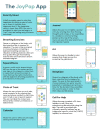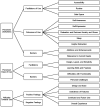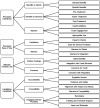Female youth and mental health service providers' perspectives on the JoyPop™ app: a qualitative study
- PMID: 37829596
- PMCID: PMC10566298
- DOI: 10.3389/fdgth.2023.1197362
Female youth and mental health service providers' perspectives on the JoyPop™ app: a qualitative study
Abstract
Introduction: Mobile health (mHealth) apps are a promising adjunct to traditional mental health services, especially in underserviced areas. Developed to foster resilience in youth, the JoyPop™ app has a growing evidence base showing improvement in emotion regulation and mental health symptoms among youth. However, whether this novel technology will be accepted among those using or providing mental health services remains unknown. This study aimed to evaluate the JoyPop™ app's acceptance among (a) a clinical sample of youth and (b) mental health service providers.
Method: A qualitative descriptive approach involving one-on-one semi-structured interviews was conducted. Interviews were guided by the Technology Acceptance Model and were analyzed using a deductive-inductive content analysis approach.
Results: All youth (n = 6 females; Mage = 14.60, range 12-17) found the app easy to learn and use and expressed positive feelings towards using the app. Youth found the app useful because it facilitated accessibility to helpful coping skills (e.g., journaling to express their emotions; breathing exercises to increase calmness) and positive mental health outcomes (e.g., increased relaxation and reduced stress). All service providers (n = 7 females; Mage = 43.75, range 32-60) perceived the app to be useful and easy to use by youth within their services and expressed positive feelings about integrating the app into usual care. Service providers also highlighted various organizational factors affecting the app's acceptance. Youth and service providers raised some concerns about apps in general and provided recommendations to improve the JoyPop™ app.
Discussion: Results support youth and service providers' acceptance of the JoyPop™ app and lend support for it as an adjunctive resource to traditional mental health services for youth with emotion regulation difficulties.
Keywords: Technology Acceptance Model (TAM); mental health; mobile health (mHealth) app; qualitative; resilience; service providers; the JoyPop app; youth.
© 2023 Malik, Perez, Toombs, Schmidt, Olthuis, Charlton, Grassia, Squier, Stasiuk, Bobinski and Mushquash.
Conflict of interest statement
The authors declare that the research was conducted in the absence of any commercial or financial relationships that could be construed as a potential conflict of interest.
Figures



Similar articles
-
Exploring the relevance of a psychology-based resilience app (JoyPop™) for Indigenous youth.Child Abuse Negl. 2024 Feb;148:106343. doi: 10.1016/j.chiabu.2023.106343. Epub 2023 Jul 12. Child Abuse Negl. 2024. PMID: 37451896 Clinical Trial.
-
Exploring the feasibility of a mental health application (JoyPopTM) for Indigenous youth.Front Psychiatry. 2023 Oct 6;14:1269347. doi: 10.3389/fpsyt.2023.1269347. eCollection 2023. Front Psychiatry. 2023. PMID: 37867769 Free PMC article.
-
Increasing access to mental health supports for 12-17-year-old Indigenous youth with the JoyPop mobile mental health app: study protocol for a randomized controlled trial.Trials. 2024 Apr 4;25(1):234. doi: 10.1186/s13063-024-08076-y. Trials. 2024. PMID: 38575945 Free PMC article.
-
The Needle in the Haystack: Identifying Credible Mobile Health Apps for Pediatric Populations during a Pandemic and beyond.J Pediatr Psychol. 2020 Nov 1;45(10):1106-1113. doi: 10.1093/jpepsy/jsaa094. J Pediatr Psychol. 2020. PMID: 33068424 Free PMC article. Review.
-
Menstrual Tracking Mobile App Review by Consumers and Health Care Providers: Quality Evaluations Study.JMIR Mhealth Uhealth. 2023 Mar 1;11:e40921. doi: 10.2196/40921. JMIR Mhealth Uhealth. 2023. PMID: 36857125 Free PMC article. Review.
Cited by
-
Usability and Quality of the JoyPop App: Prospective Evaluation Study.JMIR Hum Factors. 2025 Jul 4;12:e65472. doi: 10.2196/65472. JMIR Hum Factors. 2025. PMID: 40614082 Free PMC article.
-
Promoting mental health and wellbeing among post-secondary students with the JoyPop™ app: study protocol for a randomized controlled trial.Trials. 2024 Sep 2;25(1):576. doi: 10.1186/s13063-024-08424-y. Trials. 2024. PMID: 39223596 Free PMC article.
-
Acceptance of a mental health app (JoyPopTM) for postsecondary students: a prospective evaluation using the UTAUT2.Front Digit Health. 2025 Feb 18;7:1503428. doi: 10.3389/fdgth.2025.1503428. eCollection 2025. Front Digit Health. 2025. PMID: 40041123 Free PMC article.
-
Personalization variables in digital mental health interventions for depression and anxiety in adolescents and youth: a scoping review.Front Digit Health. 2025 May 15;7:1500220. doi: 10.3389/fdgth.2025.1500220. eCollection 2025. Front Digit Health. 2025. PMID: 40444184 Free PMC article.
-
Increasing Access to Mental Health Supports for 18- to 25-Year-Old Indigenous Youth With the JoyPop Mobile Mental Health App: Study Protocol for a Randomized Controlled Trial.JMIR Res Protoc. 2025 Jan 30;14:e64745. doi: 10.2196/64745. JMIR Res Protoc. 2025. PMID: 39883939 Free PMC article.
References
-
- MHASEF Research Team. The mental health of children and youth in Ontario: a baseline scorecard. Toronto, ON: Institute for Clinical Evaluative Sciences; (2015).
-
- Mental Health Commission of Canada. Changing directions, changing lives: the mental health strategy for Canada. Calgary, AB: MHCC; (2012).
-
- Children’s Mental Health Ontario. Kids can’t wait: 2020 report on wait lists and wait times for child and youth mental health care in Ontario (2020). Available at: https://cmho.org/wp-content/uploads/CMHO-Report-WaitTimes-2020.pdf (Accessed March 15, 2022).
-
- Mental Health Commission of Canada. E-Mental Health in Canada: Transforming the Mental Health System Using Technology - a briefing document. Ottawa, ON: MHCC; (2014).
LinkOut - more resources
Full Text Sources

